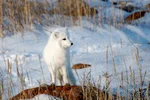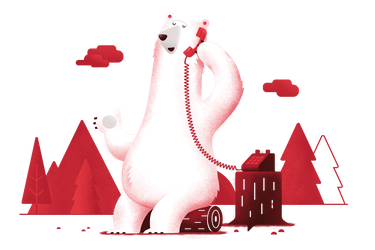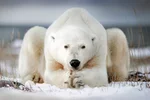Churchill's amazing arctic wildlife
Churchill, Manitoba is home to a wide variety of rare animal species. From the ferocious polar bear to the playful beluga whale, animal lovers who visit the Hudson Bay town can see a large number of interesting wildlife.

One of the more beautiful creatures found in the region is the Arctic fox (also called the snow fox or white fox). This small canid evolved to feature a thick, albino coat. This trait allows the Arctic fox to blend in with snowy surroundings, easily catch its prey and hide from large predators like the polar bear.
Popular wildlife tours

Keep reading or chat with one of our local travel experts. We’re passionate about Canada and can help you at any stage of your vacation planning.
Canada's Snow Foxes
The snow fox, another name for the Arctic fox, was once abundant in arctic regions of the northern hemisphere. While some of the species sub-populations are still thriving, other communities (such as those found in Scandinavia) are considered endangered.
Luckily, these animals are still numerous in Churchill. Thousands of visitors each year flock to the town to view the Arctic fox and other varieties of wildlife that can't be found in lower latitudes. If you're interested in getting an up close view of Manitoba's Arctic foxes, Canada Polar Bears can help. We've assisted people worldwide in booking their dream Canadian vacations.
Canada's snow foxes are very interesting creatures. They have adapted well to live near human settlements such as Churchill, but have not lost a bit of their natural, hunting instinct. Their hearing is very powerful, and can be used to locate prey under thick layers of snow and ice. When there is little food to hunt for, the Arctic fox will scavenge for leftovers from the area's larger carnivores. What makes up an Arctic fox's diet? The short answer is: any kind of meat it can find. The species is particularly fond of lemming, but has also been known to catch a delicious hare, carrion or other small prey if the opportunity arises.
Bring a tripod
Tripods are a great tool for capturing wildlife photos. Plus, you never know if the Northern Lights might make an appearance at night! A tripod means you are always ready for stable, long exposure photos of the auroras.

Beluga whales
While these animals are usually only found in the extreme north, each summer, thousands of beluga whales congregate in the Churchill River to calf.
Beluga whales, easily recognizable by their distinctive white coloration, are often called the "canaries of the sea" because of their high-pitched vocalizations. Unlike most whales, belugas lack a dorsal fin — this allows them to navigate under ice-covered waters more easily. This adaptation is particularly useful in their Arctic habitat where they are often found.
Beluga whales are uniquely adapted to thrive in Arctic environments. They have a specialized physiology which includes a thick layer of blubber that helps insulate them from the frigid waters and stores energy for long migrations.
Beluga whales are highly social animals and are known to travel in groups called pods, which can consist of anywhere from a few individuals to hundreds. Within these pods, belugas exhibit complex social behaviors, including communication through a variety of clicks, whistles, and other vocalizations. They are also known for their playful nature, often seen engaging in acrobatic displays such as breaching and spyhopping.

Polar bears: the king of the North
The world’s largest species of bear, polar bears are at the top of the Arctic food chain. A full-grown male weighs between 350 and 700 kg (770 to 1,545 lbs).
Nearly 60 percent of the planet’s polar bears live in Canada’s far north. Your best chance to see a polar bear in the wild is in Churchill, Manitoba, the Polar Bear Capital of the World. In the fall, hundreds of polar bears gather along the shore of Hudson Bay in October and November. They are waiting for the water to freeze over and they can head out to hunt seals.

Why book your trip with Fresh Tracks Canada?
Unforgettable Canadian vacations made just for you
Enjoy local expertise and guidance with a fully planned itinerary. Personalize your trip by adding extra time in Canada at the start or end of your Northern Lights tour.
We take care of all the details
Relax and focus on making memories. Let us make all of the bookings for you, including your guided polar-bear tour, hotels, excursions and activities, and transfers.
Support when you need it
We’re here to make sure you get the inside scoop before you even leave home. And you can relax on your vacation because you know that we’re a phone call away if you have any questions while you’re in Canada.
What Our Customers Say
Discover more about polar bears
Discuss your polar-bear tour with a Canadian travel expert


Sign up for travel inspiration
Our newsletter is full of local tips and insights for an unforgettable Canadian vacation.
![Lori and Mike review of their [object Object] trip](https://cdn.bfldr.com/UAHFH8T4/as/kkpfbbw5r6gtv7pctmk4gc7/Lori_Mike_499?auto=webp&format=webp&width=75)
![Anne and Marvin review of their [object Object] trip](https://cdn.bfldr.com/UAHFH8T4/as/trcm5jvn8mvrr9nhjc6xn58/Anne_Marvin_497?auto=webp&format=webp&width=75)
![Julie and Suzanne review of their [object Object] trip](https://cdn.bfldr.com/UAHFH8T4/as/s9kx3v2bz6f963fxj2hbjpn/Julie_Suzanne_496?auto=webp&format=webp&width=75)
![Emily review of their [object Object] trip](https://cdn.bfldr.com/UAHFH8T4/as/93xhcvcjpmnqt4j92b6v87/Emily_384?auto=webp&format=webp&width=75)


